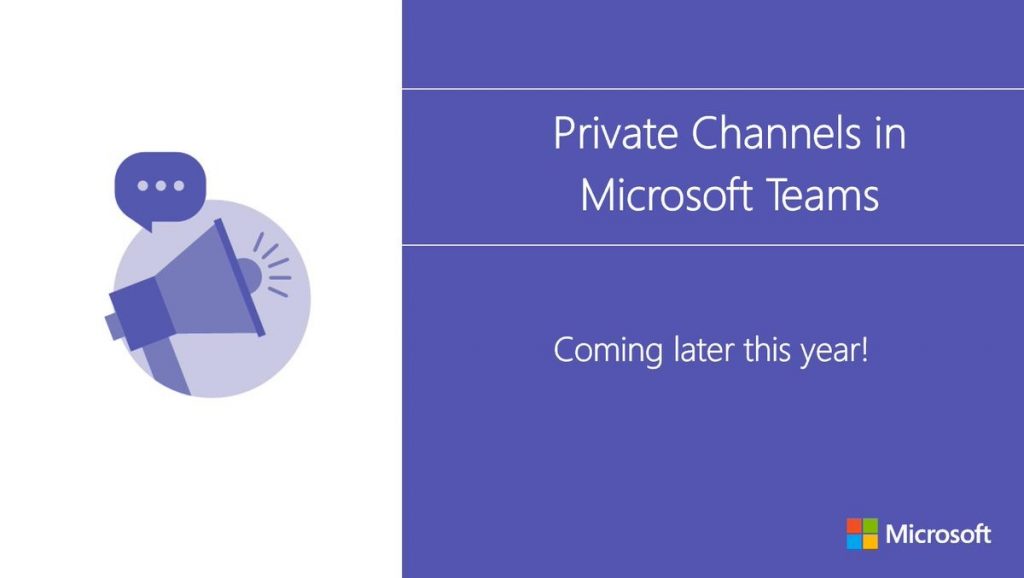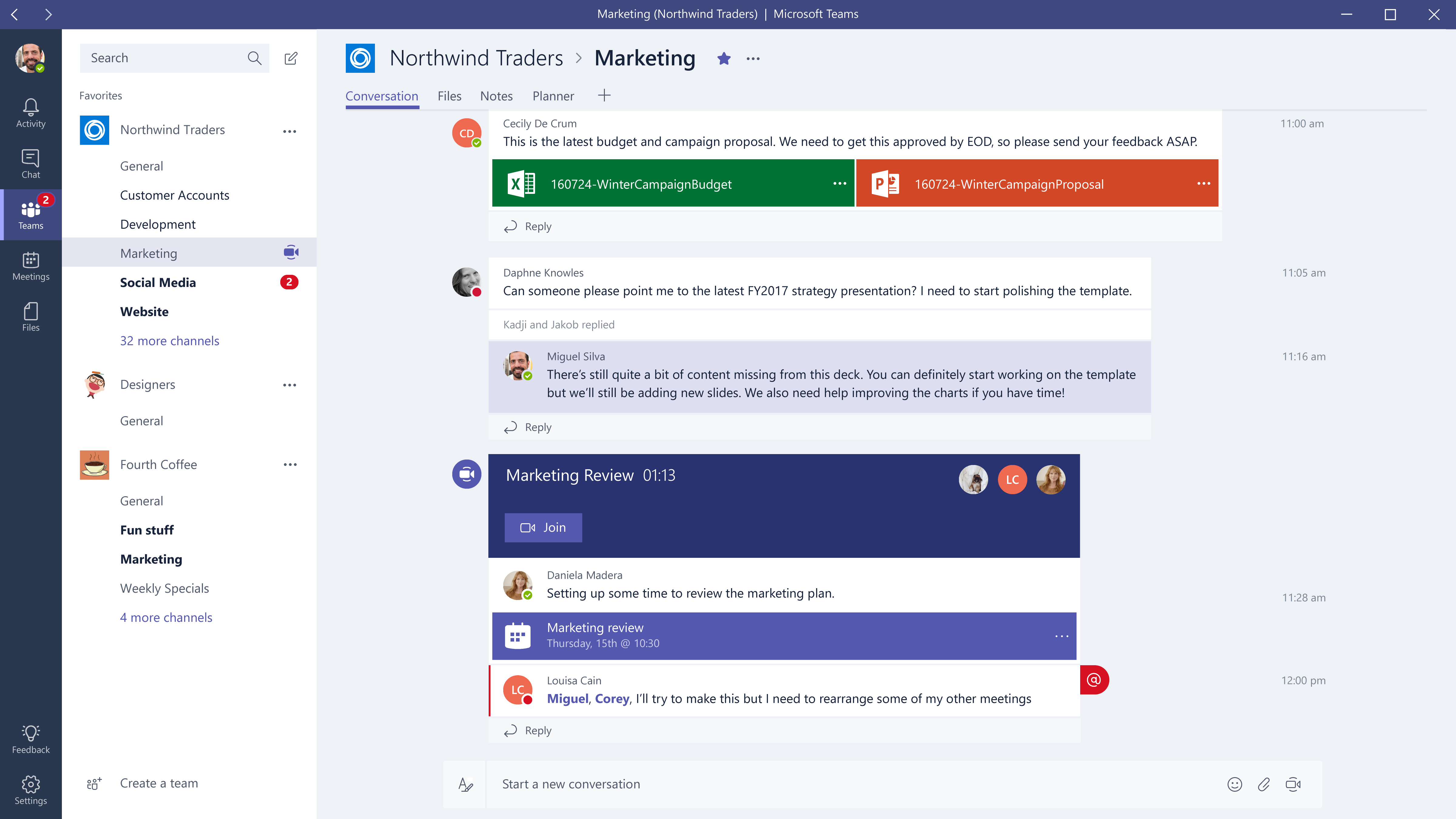There has been an update! Get the latest on when, why and how to deploy private channels across your organization by reading Getting Ready for Private Channels in Microsoft Teams: Part 1.
The discussion of including private channels in Microsoft Teams has been a long one. The concept sounds straightforward enough; private channels would only be seen and accessible by the creator and whoever he/she invites. In practice, however, the feature has been a major development challenge. Here’s what you need to know.
Facts:
- Private channels are easily the most requested feature on User Voice
- The feature has been in development for over two years now
- On March 19th it was announced that private channels will be coming out later this year

According to User Voice, people generally want more options when it comes to creating channels in Microsoft Teams. Specifically, they want channels that are:
- Public-Open (Visible anywhere including outside the organization that anyone can join)
- Public-Invitation (Visible anywhere including outside the organization; must be invited)
- Company-Open (Only visible inside the organization and anyone inside can join; those outside the organization must be invited)
- Company-Invitation (Only visible inside the organization, must be invited)
- Secret (Invisible to everyone except existing members, must be invited)
Why People Want It
So, what’s so special about private channels, anyway? Why’s the demand so high?
Well, private channels would enable admins to have more granular control over who can and can’t access certain content. Sensitive material could be more easily gated. Having private channels would also make something like a manager/executive-only chat within a Team possible.
This is a good breakdown of the private channels in MS Teams situation: Click To TweetWhy People Don’t Want It
Microsoft Teams is all about open collaboration. It was designed to make working with others as seamless as possible. Once you’re in a Team you have access to everything in there. By implementing more controls and requiring the team owner to manage permissions for every private team that gets created, it can quickly become antithetical to the purpose of the platform.
Pushing for private channels can also be seen as unnecessary. You can arguably just create a new team if you want privacy. And if you want a private chat between two or more managers/executives, why not create a regular group chat? These are all workable (though not necessarily as convenient) options.
Potential Issues
Whether you’re for or against private channels in Microsoft Teams, they’re undeniably a popular request. So why have they taken so long to be implemented?
Well, as previously mentioned, channels in Teams weren’t originally created to be blocked off. Because of this, the architecture of channels doesn’t lend itself to being private.

Every Team that’s created is enabled by other facets of Office 365. For instance, Teams need Planner for task management and SharePoint for file storage. If a certain channel in a Team went private…
…Planner permissions would be broken.
…SharePoint permissions would be broken.
…Stream permissions would be broken.
…Tab level permissions would be broken.
Needless to say, the Microsoft Teams team had to overcome a ton of obstacles to make part of their open collaboration platform closed off. Were all the delays worth it? We’ll have to wait until the end of the year to find out.
See how you can manage your private channels with AvePoint’s Microsoft Teams management solution!
Feel free to comment below and let us know how you think private channels will impact Microsoft Teams going forward!
There has been an update! Get the latest on when, why and how to deploy private channels across your organization by reading Getting Ready for Private Channels in Microsoft Teams: Part 1.







The need to have private channels stems from a need to share material with outside your normal team or to limit the access to a smaller sub-group. Private channels won’t solve this since you will always discover that “hey I want to share these files, but not the rest of the files that happens to be here”. Proper publishing and authoring workspace functionality would solve much of these needs in a better way I think.
Thanks for reading Gil. That’s a fair sentiment, and one that seems to be popular among those more tentative about private channel implementation. We’re looking forward to seeing how well they work out for organizations following the eventual launch.
This is a really interesting article. Thank you! One thing that would be important to us to implement private teams is the ability to archive channels. Without this, private channels only takes us so far. Those two functions combined are a major decision factor in our Teams architecture. We either create a plethora of teams to control communication noise, or we create channels to consolidate project conversation. I wish this were already implemented because we need to make this decision asap.
We’re glad you found this helpful Shawn! And indeed, we’ll have to wait and see if Microsoft enables channel archiving eventually.
Hi, we need to create a Planner tab into a private channel in my Team. I´m sure that a lot of us need the same feature. Does anybody know when we’ll have that? We have this into a public channel in the same Team…
Can’t wait to see this implemented.
You’re certainly not alone there. Thanks for reading!
While I know many of our users say they want Private Channels, the whole “customized permissions for…” issue mentioned above has me cringing at the thought. I think there is a valid need for one or more “Owner Only” channels in a Team and the (permissions) infrastructure is already there to support it. Business users have a hysterically terrible track record (at least in our environment) when it comes to managing permissions. I have literally had (SharePoint) site owners lecture me for an hour on why it’s important that their content be “secure”, then turn around and give all 30 employees in their department “Full Control” permissions to the site directly (ie: NOT by putting them in the Owners group). Introducing any kind of “permissions” management into Teams is absolutely going to confuse and frustrate people.
Hey Chad, thanks for sharing your thoughts. Understanding permissions management is certainly an obstacle users are going to have to undertake. Proper (and consistent) training will likely be a must.
I am having a slightly different issue with the private channels. I was testing a few channels before opening to the rest of my Team, but once selecting private, there’s no way to revert it to public. Is there a fix to this issue? Thank you in advance!
Hey Mat, thanks for reaching out. Yes – as long as you’re a Team “Owner” you have the ability to edit the Team via the ellipses next to your Team name. It’s at this point that you’re able to change the Team name as well as the “Privacy” setting. Don’t be confused with the Team “Manage Team” menu which contains different options.
Hey Mat, Could you please let us know how you have created private channel? I did not find any way to create it.
Thank you
I managed to sort out my issues with the channels, but the problem is that I’m not the “super admin” in mi org, so for instance, they’ve removed the ability to create private channels.
In the project areas I work on, there is a real problem of Teams proliferation in order to maintain Chinese walls between different parts of projects. If we want to move people away from email, and also not be overwhelmed with creating customised SharePoint sites, plus other governance arrangements that need to be made, then private channels provides a good balance.
One area where it is important is in inter-institutional teams where a substantial amount of the membership are guests. We need to have an internal channel or two to cover sensitive communications. If we broke these out into private chats, then we need to have a way of hooking these into the governance controls for the main team. This is not straightforward – how do we identify and archive private chats with the main team communications?
Hey Mike, thanks for the comment! While Microsoft doesn’t have a solution for this at the moment, we can currently migrate Teams and their channels (and Slack channels) from tenant to tenant, and even consolidate Teams channels (or Slack channels) into one Team. However, we don’t support pulling private chat data into a Teams channel.
Private chat information is copied from the Teams application in Azure into hidden folders inside user’s Exchange email boxes for compliance purposes, but there are no APIs to access this information. We’re continuing to work towards supporting this information for migration, content moves, and backup and restore use cases.
“It’s also worth noting that those chat conversations will remain in Teams even if you remove the users. You could communicate a naming convention to make them easy to find. It’s also possible to archive the private chat information by archiving the user email boxes in question.”
As a product of the Government and private industry Legal environment, I must assure the integrity & absolute control of project information and its respective classifications or in Legal sector for client, case and HIPAA information on a strict cleared or “need-to-know” basis. It appears that Microsoft leadership, for whatever reason, lacks the corporate will to make this happen in the Teams environment. I will be patient for a while longer. However, in the absence of any publicized movement on this front, I will have to withdraw from Teams.
Hey John, thanks for commenting. I think situations like yours are one of the reasons Microsoft has decided to move forward with private channel implementation (though it’s taken awhile to get there). This should make the control and privacy you’re looking for a reality in Teams; there’s just not a solid release date yet.
I doubt that it’s “corporate will” – there are many engineering issues that have to be solved and prioritised to support Teams. You don’t build a pyramid from the apex down – broader feature sets and infrastructure are required first. Microsoft has already been making progress on HIPAA, information barriers, data residency and other governance areas that show clear movement on this front.
Very clear and excellent article.
I would also like to share few more tips on Microsoft Teams – Private Channels
https://www.youtube.com/watch?v=yTyB6HX1Xng&t=24s